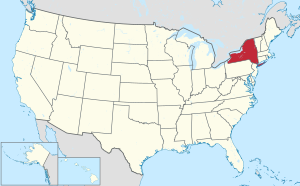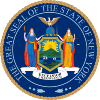
New York (state)
U.S. state / From Wikipedia, the free encyclopedia
Dear Wikiwand AI, let's keep it short by simply answering these key questions:
Can you list the top facts and stats about New York State?
Summarize this article for a 10 year old
New York, also called New York State,[lower-alpha 2] is a state in the Northeastern United States. One of the Mid-Atlantic states, it borders New Jersey, the Atlantic Ocean, New England, Canada and the Great Lakes.[lower-alpha 3] With almost 19.6 million residents, it is the fourth-most populous state in the United States and eighth-most densely populated as of 2023.[5] New York is the 27th-largest U.S. state by area, with a total area of 54,556 square miles (141,300 km2).[2]
New York | |
|---|---|
| State of New York | |
| Nickname: | |
| Motto(s): | |
| Anthem: "I Love New York" | |
 Map of the United States with New York highlighted | |
| Country | United States |
| Before statehood | Province of New York |
| Admitted to the Union | July 26, 1788 (11th) |
| Capital | Albany |
| Largest city | New York |
| Largest county or equivalent | Kings (Brooklyn) |
| Largest metro and urban areas | New York metropolitan area |
| Government | |
| • Governor | Kathy Hochul (D) |
| • Lieutenant Governor | Antonio Delgado (D) |
| Legislature | State Legislature |
| • Upper house | State Senate |
| • Lower house | State Assembly |
| Judiciary | New York Court of Appeals |
| U.S. senators |
|
| U.S. House delegation |
|
| Area | |
| • Total | 54,555[2] sq mi (141,298[2] km2) |
| • Land | 47,126 sq mi (122,057 km2) |
| • Water | 7,429 sq mi (19,240 km2) 13.6% |
| • Rank | 27th |
| Dimensions | |
| • Length | 330 mi (530 km) |
| • Width | 285 mi (455 km) |
| Elevation | 1,000 ft (300 m) |
| Highest elevation | 5,344 ft (1,629 m) |
| Lowest elevation | 0 ft (0 m) |
| Population (2023) | |
| • Total | 19,571,216[5] |
| • Rank | 4th |
| • Density | 416.42/sq mi (159/km2) |
| • Rank | 8th |
| • Median household income | $75,200[6] |
| • Income rank | 14th |
| Demonym | New Yorker |
| Language | |
| • Official language | None |
| • Spoken language | |
| Time zone | UTC−5 (EST) |
| • Summer (DST) | UTC−4 (EDT) |
| USPS abbreviation | NY |
| ISO 3166 code | US-NY |
| Traditional abbreviation | N.Y. |
| Latitude | 40° 30′ N to 45° 1′ N |
| Longitude | 71° 51′ W to 79° 46′ W |
| Website | ny |
| List of state symbols | |
|---|---|
 | |
 | |
 | |
| Slogan | I Love New York |
| Living insignia | |
| Bird | Eastern bluebird |
| Fish | Brook trout (fresh water), Striped bass (salt water) |
| Flower | Rose |
| Fruit | Apple |
| Insect | Nine-spotted ladybug |
| Mammal | North American beaver |
| Reptile | Common snapping turtle |
| Tree | Sugar maple, Lilac bush |
| Inanimate insignia | |
| Beverage | Milk |
| Food | Yogurt |
| Fossil | Eurypterus remipes |
| Gemstone | Garnet |
| Shell | Bay scallop |
| Sport | Baseball |
| State route marker | |
 | |
| State quarter | |
 Released in 2001 | |
| Lists of United States state symbols | |
New York has a varied geography. The southeastern part of the state, known as Downstate, encompasses New York City, the most populous city in the United States, with over twice the population of Los Angeles, the nation's second-largest city; Long Island, the nation's most populous island; and the suburbs and wealthy enclaves of the lower Hudson Valley. These areas are the center of the New York metropolitan area, a sprawling urban landmass,[8][9] and account for approximately two-thirds of the state's population. The much larger Upstate area spreads from the Great Lakes to Lake Champlain, and includes the Adirondack Mountains and the Catskill Mountains (part of the wider Appalachian Mountains). The east–west Mohawk River Valley bisects the more mountainous regions of Upstate, and flows into the north–south Hudson River valley near the state capital of Albany. Western New York, home to the cities of Buffalo and Rochester, is part of the Great Lakes region and borders Lake Ontario and Lake Erie. Central New York is anchored by the city of Syracuse; between the central and western parts of the state, New York is dominated by the Finger Lakes, a popular tourist destination. To the south, along the state border with Pennsylvania, the Southern Tier sits atop the Allegheny Plateau, representing the northernmost reaches of Appalachia.
New York was one of the original Thirteen Colonies that went on to form the United States. The area of present-day New York had been inhabited by tribes of the Algonquians and the Iroquois Confederacy Native Americans for several thousand years by the time the earliest Europeans arrived.[10] Stemming from Henry Hudson's expedition in 1609,[11] the Dutch established the multiethnic colony of New Netherland in 1621. England seized the colony from the Dutch in 1664, renaming it the Province of New York.[12] During the American Revolutionary War, a group of colonists eventually succeeded in establishing independence, and the state ratified the then new United States Constitution in 1788. From the early 19th century, New York's development of its interior, beginning with the construction of the Erie Canal, gave it incomparable advantages over other regions of the United States.[13] The state built its political, cultural, and economic ascendancy over the next century, earning it the nickname of the "Empire State." Although deindustrialization eroded a portion of the state's economy in the second half of the 20th century, New York in the 21st century continues to be considered as a global node of creativity and entrepreneurship,[14] social tolerance,[15] and environmental sustainability.[16][17]
The state attracts visitors from all over the globe, with the highest count of any U.S. state in 2022.[18] Many of its landmarks are well known, including four of the world's ten most-visited tourist attractions in 2013: Times Square, Central Park, Niagara Falls and Grand Central Terminal.[19] New York is home to approximately 200 colleges and universities, including Ivy League members Columbia University and Cornell University, and the expansive State University of New York, which is among the largest university systems in the nation.[20][21][22][23] New York City is home to the headquarters of the United Nations,[24] and it is sometimes described as the world's most important city,[25][26] the cultural,[27][28] financial,[29][30][31] and media epicenter,[32][33] and the capital of the world.[34][35]

